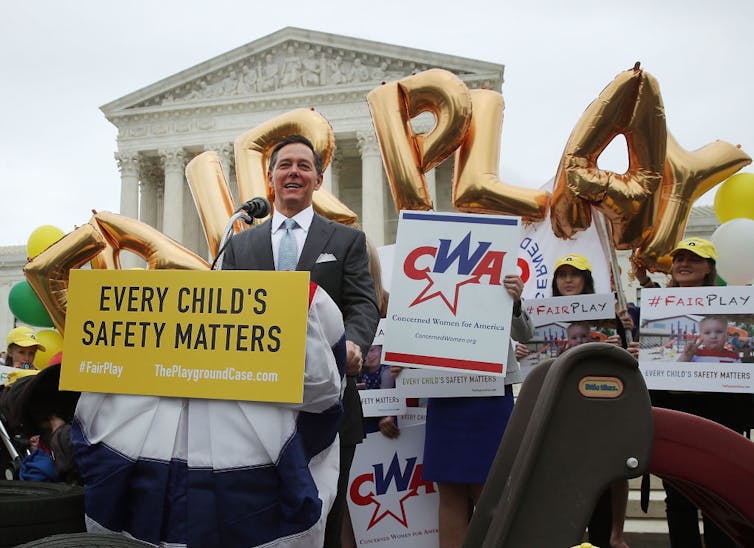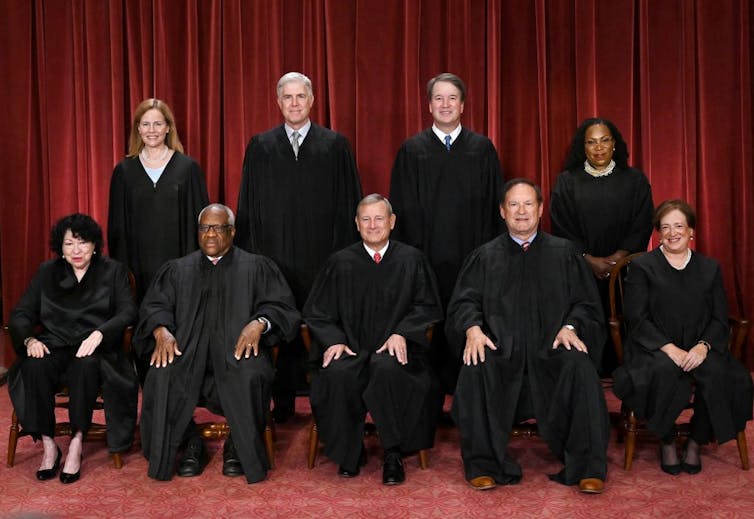
U.S. courts have long wrestled with the extent to which government funding can be used at private religious schools. School-choice advocates have won key cases at the Supreme Court in recent years, opening up more ways for public dollars to support faith-based education. But Oklahoma pushed the debate into unchartered territory this spring with a proposal for a school that would have been the first of its kind: a Catholic charter, primarily paid for by taxpayers.
On April 11, 2023, the five-person board responsible for approving Oklahoma charters unanimously voted to reject the proposal, due to concerns about its governance structure and plans for special education students, among other issues. However, it gave organizers 30 days to revise the proposal and try again.
Charter schools, which are publicly funded but generally run by independent organizations, have attracted ardent fans and foes since they started in the early 1990s. Yet the key question in this case is not whether a charter would help or harm local education, but whether explicitly religious instruction at charter schools is constitutional, given the First Amendment’s protections against government establishment of religion.
In late 2022, the then-attorney general of Oklahoma argued that a state law barring faith-based charter schools was actually unconstitutional. The new attorney general who took office in January 2023 soon rescinded the opinion, leaving the charter school proposal in legal limbo – and making it even more likely to wind up at the Supreme Court if the school board eventually approves the charter.
Recent trend
Advocates of expanding public funding to faith-based schools were encouraged by three recent Supreme Court cases that upheld greater aid to their students. All three of these cases relied on a legal idea I have written about called the “child benefit test.” Essentially, according to this concept, it is constitutional under some circumstances to provide public funds to students who attend faith-based private schools, or their parents – but not directly to the schools.
The first of these decisions, 2017’s Trinity Lutheran Church of Columbia v. Comer, dealt with a private Christian preschool that was denied public grants to update its playground. School administrators sued, arguing that to deny generally available funding constituted religious discrimination, in violation of the First Amendment’s protections for freedom of religion. The high court agreed.

Three years later, Espinoza v. Montana Department of Revenue further opened up government aid to private religious school pupils, relying on the Trinity Lutheran decision. A 5-4 majority ruled that Montana’s tax credit program for parents sending their children to independent schools must apply even if those schools are faith-based.
In 2022, the Court extended this perspective in a case from Maine, Carson v. Makin. Maine, with its low population density, pays parents in areas lacking their own public schools to either transport their children to nearby public schools or a secular private school. The Supreme Court found that this program should apply to parents without a local public school who wish to send their child to a religious school, as well.
Rethinking church and state?
By expanding the boundaries of permissible aid, these three cases have boosted proponents’ hopes for even greater public funding for private faith-based schools – and now, with the charter proposal, hopes that there might be a path ahead for public religious schools, entirely paid for with taxpayer money. Yet, it is important to keep in mind what likely prompted these changes in the first place: new faces on the Supreme Court. A majority of today’s justices tend to favor an “accommodationists” interpretation of the First Amendment, meaning they largely reject the idea that it demands a “wall of separation” between church and state, so long as the government is not privileging one faith over another.
Nevertheless, the parameters of the “child benefit test” often used to justify greater public funding has been evolving for years. The concept – which is one that legal scholars use to describe the Supreme Court’s arguments, not a term the court has used itself – first emerged in a 1947 dispute from New Jersey, Everson v. Board of Education. In that case, the court upheld a state statute that allowed local school boards to transport students to faith-based schools – mostly Roman Catholic ones – reasoning that the students, not the schools themselves, were the primary beneficiaries of state aid.
In another illustrative case, 2002’s Zelman v. Simmons-Harris, the Supreme Court allowed parents whose children attended Cleveland’s public school system, which was then failing state standards, to use public vouchers to attend faith-based schools. A majority of justices upheld the program’s constitutionality because, again, students were the primary beneficiaries, not the religious schools themselves. Moreover, students attended these schools as a result of their parents’ free choices, not because doing so was required by the state.

Eyes on Oklahoma
Now, in what may be the largest expansion of the child benefit test, legislators in various states are considering laws to expand how parents can participate in public education fund programs even if their children attend private religious schools, such as by broadening voucher or tax-credit programs. The Oklahoma proposal, however, had been the first to consider establishing a charter school with religious instruction and standards.
Charters, which trace their origins to Minnesota in 1991, are publicly funded and part of local school districts, yet free from many regulations, such as standards about curricular content and teacher qualifications. The idea of faith-based charters has attracted proponents for more than 20 years, but they have had little success. If the proponents of the Catholic proposal in Oklahoma reapply to the school board and eventually succeed, it would likely encourage similar approaches elsewhere.
If states authorize faith-based charters, the new schools will likely be a boon to their religious groups and facilitate more students’ ability to attend. Proponents of charters, whether traditional or faith-based, support them as part of the larger school choice movement that seeks to give parents in failing districts opportunities to move their children into better schools without paying private school tuition.
Nevertheless, faith-based charters are likely to raise new headaches for their supporters, too. Charters are largely exempt from some state standards, but not all, and faith-based schools that converted into charters could be subject to greater government oversight about issues such as policies on LGBTQ+ students and staff – a longtime sticking point – or having to accept students with disabilities, just as all public schools do.
While this legal battle is just heating up, it has the potential to reshape public education as we have know it.
Charles J. Russo ne travaille pas, ne conseille pas, ne possède pas de parts, ne reçoit pas de fonds d'une organisation qui pourrait tirer profit de cet article, et n'a déclaré aucune autre affiliation que son organisme de recherche.
This article was originally published on The Conversation. Read the original article.







